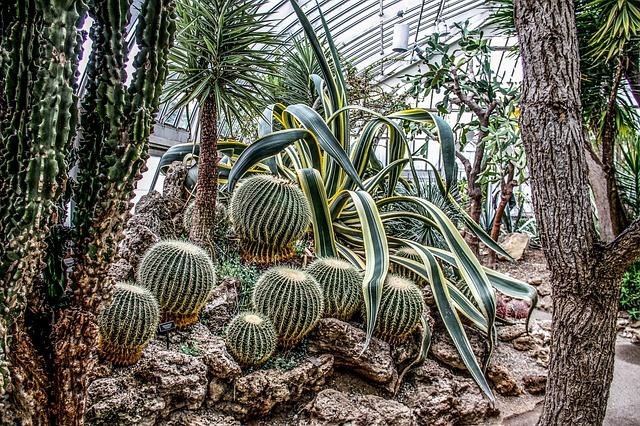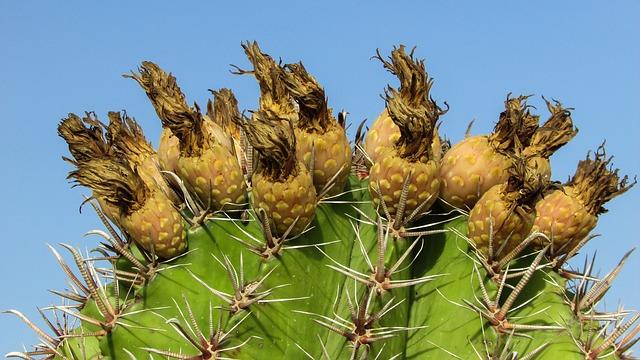Cactus is a popular variety of house plants. The flower is found in almost any home, and if we are talking about places where they love indoor plants, cacti are present in large numbers. Home care for cacti is as simple and easy as possible.
Plants from the cactus family are 2 thousand species that differ:
- dimensions;
- color;
- form.
Cacti are succulents. They store water and nutrients thanks to special fabrics. Distributed in places with a dry and arid climate, where rainfall is rare.
This feature is an advantage, as the ability to retain water makes maintenance easy. Among other succulents, plants such as:
- Money Tree;
- aloe.
Plants are easy to care for and do not require constant watering.
Another important feature of succulents is considered adaptability. They adapt to any conditions, are durable and do not fade, even if the owner forgot about them for several years, which can not be saidabout croton.
Cacti do not need constant lighting or stable temperature conditions. The only thing that can negatively affect the condition is the stress that results from neglect. To avoid this, follow the rules.
Cactus Care at Home

Caring for a flower is simple if you follow the rules that relate to creating comfortable conditions. Pay attention to:
- temperature and sunlight;
- watering;
- soil condition;
- top dressing and transplantation.
Temperature and sunlight
Most succulents love light and heat, however, this does not mean that the cactus should be kept in the sun. Periodically rearrange it in the shade, otherwise it will get a burn. In the wild, cacti grow in the shade of trees or tall bushes, but there are species that are located in the sun, which does not harm them. Optimal conditions are warm air temperature. On hot days, put it in the shade, and after the heat has fallen, return it to the light.
Adjust the amount of solar heat according to age. Keep young individuals in the sun less than adults.
Watering
Plants do not like excessive humidity. This is obvious, because cacti are adapted to hot and arid conditions. Water rarely, and after watering, make sure that the soil is completely dry. Checking the condition of the soil is simple - place a match or a thin stick in it. The first 3 cm should be dry. Only in this case re-water the plant. Consider the features of the soil. Sometimes dry soil repels water and does not absorb it. Use pot trays that allow you to nourish the roots from below.
The greatest amount of water is necessary for cacti during flowering or in the process of active growth. As a rule, growth begins in spring and continues until the end of summer. In winter and autumn, do not worry about watering, as it is not necessary.
In autumn and winter, water every 3-4 weeks, and the amount of water should be small only to moisten the soil. Obviously, cactus care is simplified during these seasons.
Remember, using pots that do not have drainage holes, create an excess of moisture for the plant and it will die.
Priming
For plants, it is recommended to use simple types of soil. Brick chips are suitable in combination with standard pot fillers. Use:
- gravel;
- crushed stone
- similar types of soil.
For plants that live indoors, use 1/3 of the crumb brick with 2/3 of the potted soil. If the plants live outdoors, increase the proportion of crumbs to 1 to 1 to create favorable conditions.
Garden stores sell cactus grounds. When choosing, consider the growing conditions and age of the cactus.
Fertilizer feed
It is not necessary to use fertilizers, since growth is carried out without them. Add fertilizer to the ground, as with with dracaenaI recommend during periods of growth. Use fertilizers for indoor plants and fertilizers of organic origin. The best option is fertilizers in granules, which well affect the state of the soil and nourish with useful substances.
Transfer
Most succulents have a superficial location of the root system, which is important when transplanting. I advise you to transplant the cactus into a pot that differs from the previous one in size. After transplanting, do not water the flower for several days, which will activate moisture reserves and heal roots that have been damaged. After transplanting, I do not recommend putting the pot in direct sunlight. Increase the amount of water and sunlight gradually.
Varieties

Cacti are divided into two varieties:
- forest;
- deserted.
Representatives of both varieties can be used as indoor plants, since each one has unique species that will complement any home collection. Desert cacti are spiny plants that grow in arid zones. Forest cacti grow in forests in subtropical and tropical climates. Representatives of both varieties have beautiful flowers, but differ in growth and care features.
Desert cacti
Desert cacti are popular for their simple care and breeding. Despite the fact that many people consider such a plant unpleasant and dangerous because of the thorns, I note that during flowering they become incredibly beautiful. The first flowers appear 3-4 years after planting. For some species, the period is sometimes delayed.
Lighting
A factor affecting health is lighting. Desert cacti need sunlight. Be wary of lighting, and do not leave it in the sun for a long time. Gradually “temper" the plant, leaving it in the sun longer.
Cacti grow most actively at a temperature of 21 degrees and a low level of humidity. In winter, the temperature of the content drops to +13 degrees. The natural habitat provides high temperatures during the day and fairly low at night.
Watering
Water only when the soil dries to a depth of three centimeters from the surface. It is best to plant in special drained pots, which will improve the circulation of moisture in the soil and improve air concentration. Transplant into a new pot rarely, as the cactus grows slowly. Using small pots speeds up flowering.
Breeding errors
Among the common mistakes that desert cactus owners make are excessive water in the winter season. In winter, they practically do not need water, and watering in a minimum amount is carried out in order to prevent drying out of the soil and roots.
Due to the excessive amount of water, the roots rot, and if the process has begun, I recommend starting growing a new plant using the processes of the old one. If there are no shoots, throw out the cactus, because it will not be able to grow and bloom due to decay and die.
Forest cacti
Forest cacti are common in tropical forests. They grow on other plants.Forest species are known for vibrant colors. In many ways, they are similar in care to desert species, but there are differences that should be considered for breeding.
Lighting and temperature
Lighting should be bright, but without direct sunlight, so in the summer, put them outdoors in a bright place, but not in direct sunlight.
During growth, a low temperature is needed, and during a lack of activity, a high temperature is needed.
Watering
I advise you to water often, especially before flowering. Water during the dormant period as soon as the soil becomes dry to the touch. As a soil, standard potted mixtures are suitable. Transplant before the growing season.
What cacti are combined with each other?

A popular trend is to plant cacti of various species in one pot. It is not surprising, because the variety of colors and shapes creates beautiful and attractive compositions.
Cactus Opuntia
A popular species that is known for its beautiful flowers and the presence of edible fruits. Types of Opuntia are low and covered with long and dense spines, the injection of which provokes unpleasant pain. Opuntia blooms with snow-white flowers, and after flowering edible fruits of a flat elongated shape appear.
Store the cactus in a bright place, however, during the summer heat, I recommend cleaning it in the shade to avoid burns. Otherwise, the care requirements are similar to those of other species.
Mammillaria
The next most popular Mammillaria. Plants have a spherical shape, pink small flowers located on the top. The spines of Mammillaria are thin and soft. There are many of them, which creates a resemblance to the hairs. The species does not need special care, and the flowering period begins from an early age, which makes it popular. There are several species that differ in shades of flowers and thorns.
Echinocactus
The owner of the largest flowers in size is Echinocactus. Flowers of various shades appear in young plants. Purple flowers located at the top. Plant height reaches 45 cm.
Hymnocalcium
Another popular species that blooms from an early age. The dimensions are small, due to which Gimnokaltsium is convenient to store and does not take up much space. The flowers are white, red or pink.
Saguaro
A view with a unique structure of branches often becomes an object of attention for lovers of room exotic. The largest species, and in natural conditions is protected by law. Saguaro supports the vital activity of living organisms, including birds, and therefore is considered an important plant.
Christmas
A vibrant species that is common in tropical forests, with wide branches without thorns. In addition, it needs moisture, which is typical for all tropical plants. It blooms in bright colors, so it is used to decorate the interior.
Cactus diseases

Inspect your home flowers regularly to see signs of illness in time.
Make sure that the optimal breeding conditions are created for the flower. Special processing products are sold that are designed to destroy plant fungi and insects - parasites.
Decay
An urgent problem for owners is rotting. It occurs due to excess water. The disease is easy to distinguish due to the appearance of dark tissues. Infection occurs on the upper part of the plant, but sometimes rot begins at the base.
Plant lice
Vegetable lice, which are often found in indoor plants, are common in cacti. Insects contribute to the appearance of a fungal disease. To get rid of parasites, I recommend using insecticides.
Thrips
Thrips are flying insects smaller than a millimeter. They affect color, as they take away nutrients. To get rid of thrips, use insect repellents or garden pest repellents.










